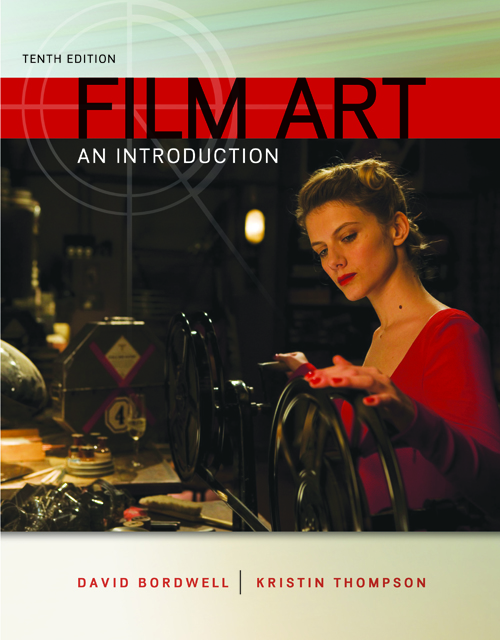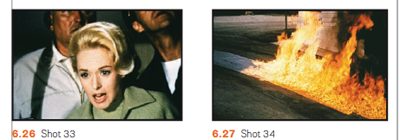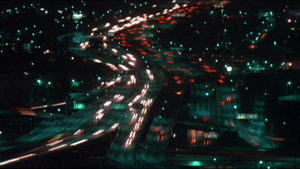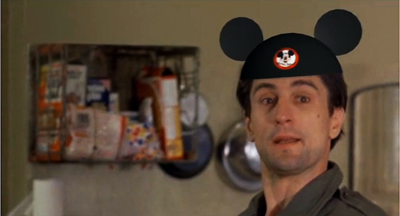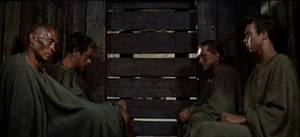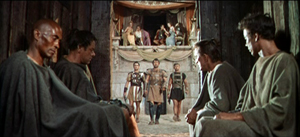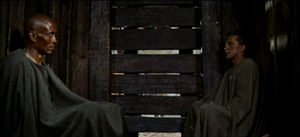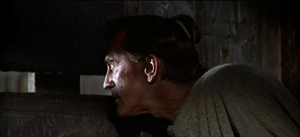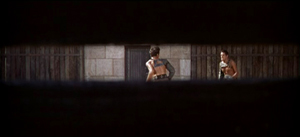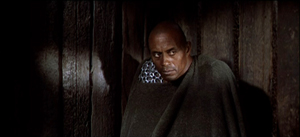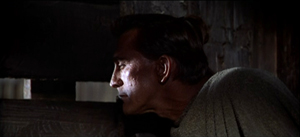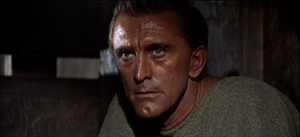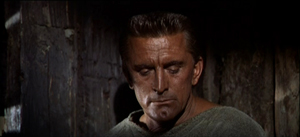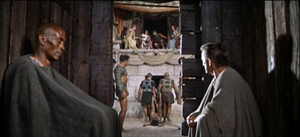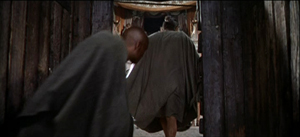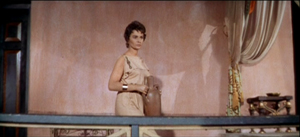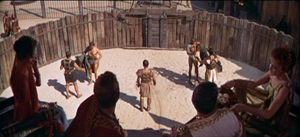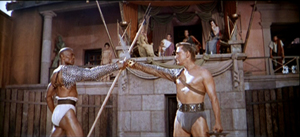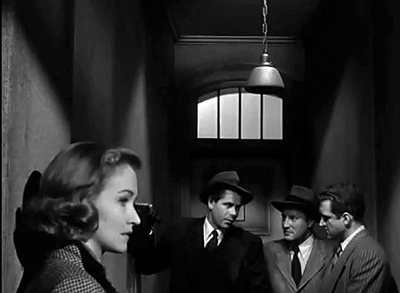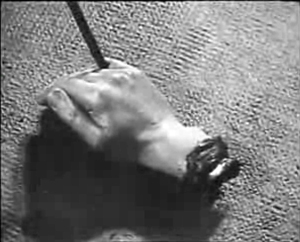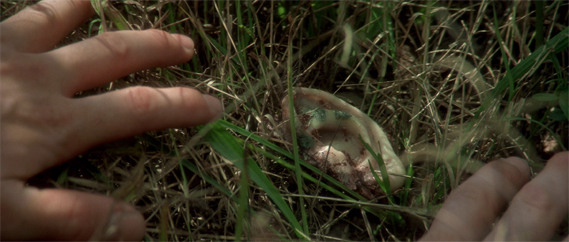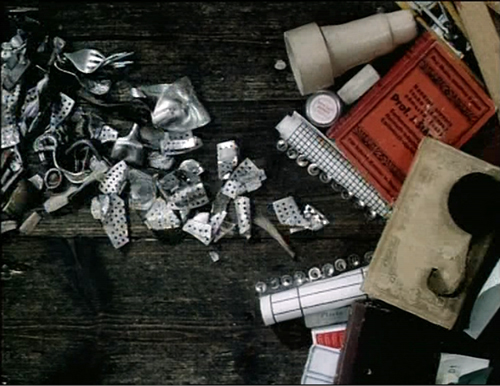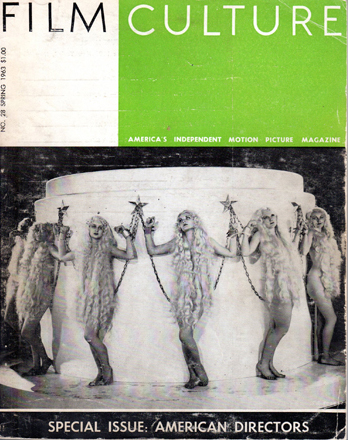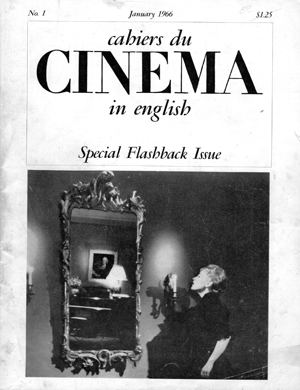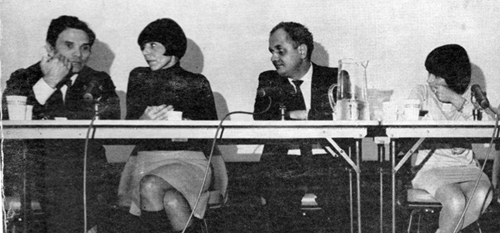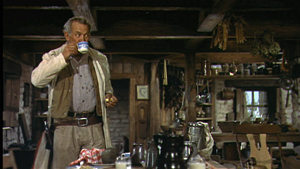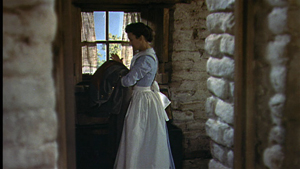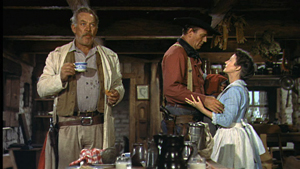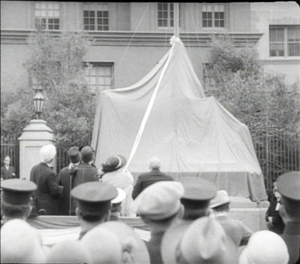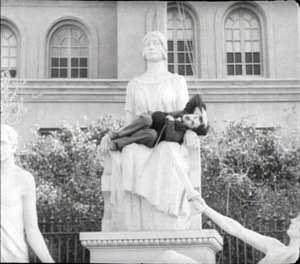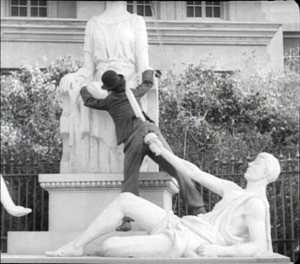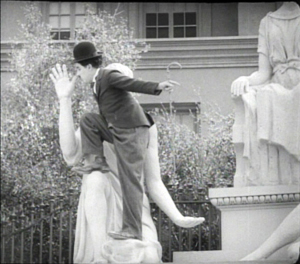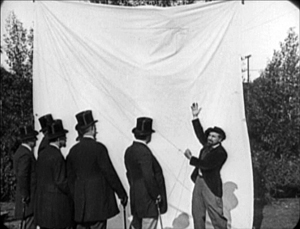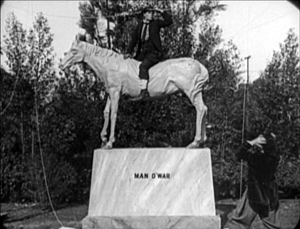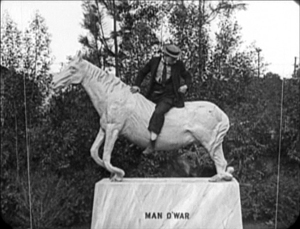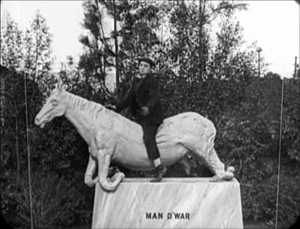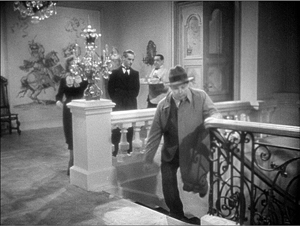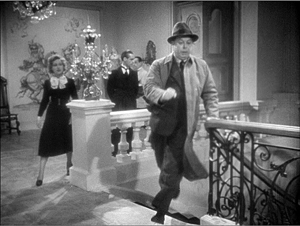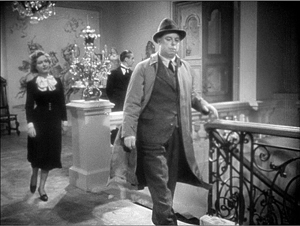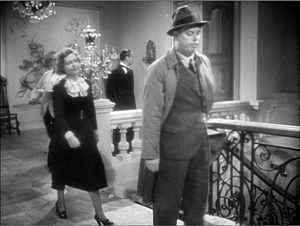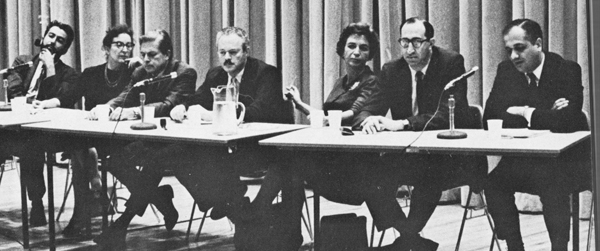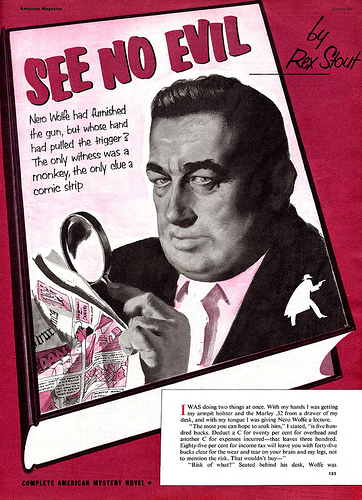Archive for June 2012
You the filmmaker: Control, choice, and constraint
DB here:
The tenth edition of our textbook, Film Art: An Introduction will be available in early July. It has so many new features that it’s our most extensive revision in at least a decade.
Kristin has already written about one of our major additions: supplemental film extracts from the Criterion Collection, with voice-over commentary and other sorts of analysis. (Go here for a sample.) These will be accessible to professors for incorporation into their syllabi. More of them may also become generally available on the Criterion website.
The text has been extensively rewritten, aiming at maximal clarity and freshness. There are many local changes too, with updated examples from a variety of films both old and new. Regular readers will notice that we have made two replacements: Koyaanisqatsi is now our example of associational form, and Švankmajer’s Dimensions of Dialogue is our example of experimental animation. Regretfully, we had to drop our earlier examples, Bruce Conner’s A Movie and Robert Breer’s Fuji, because they are available only in 16mm, and most teachers and readers don’t have access to them. On the other hand, we enjoyed analyzing the new items and think that they serve their purpose very well.
Today I’m going to point out some of the broader changes, while also considering the book’s overall approach.
Parts and wholes
When Film Art appeared in 1979, it was the first textbook in English written by people who had received Ph.D.s in film studies. Specifically, FA emerged from my teaching a lecture-and-discussion course called “Introduction to Film” to several hundred students each semester for many years.
In the mid-seventies, there were almost no film studies textbooks, and none of them seemed to us to reflect the directions of current research. As a result, the first edition of FA included topics that were emerging in the field, such as narrative theory and conceptions of ideology. It also suggested a coherent, comprehensive view of cinematic art, from avant-garde and documentary cinema to mainstream film and “art cinema.”
The book has changed since then, but its approach has remained consistent in two primary respects. For one thing, it tries to survey the basic techniques of the medium in a systematic fashion. Here the key word is “systematic.” It seemed to us that we might go beyond simple mentioning this or that technique—editing, or acting, or sound—and instead treat each technique in a more logical and thorough way. But film aesthetics wasn’t yet conceived in this way, so to a considerable extent the textbook had to offer some original ideas.
For example, most people thought of editing primarily as a means of advancing the film’s story. That’s certainly accurate up to a point, but we tried to go up a level of abstraction. We suggested that the change from shot to shot had implications for what was represented (the space shown in the shots, the time of the action presented), as well as for the sheer graphic and rhythmic qualities onscreen, independent of what was shown. That created four dimensions that the filmmaker could control, and we illustrated how Hitchcock shaped all of them in a sequence from The Birds.
Nobody before had surveyed editing’s possibilities in this multidimensional way. The result was that we were able to trace out several expressive options. We analyzed the 180-degree system for presenting story space, and Film Art became the first film appreciation textbook to explain this. We also laid out ways in which shots could manipulate the order, duration, and frequency of story action. We also considered sheerly graphic and rhythmic possibilities of editing, not all of which are tied to narrative purposes. Similarly, we tried to show that sound, another familiar technique, could be understood as a bundle of systematic options relating to sound quality, locations in space, relation to time, and other factors.
In sum, very often the array technical options had an inner logic. This urge to cover all bases helped us notice options that usually escaped critics. So by concentrating on the graphic dimension of editing, we noticed that some filmmakers tried to create pictorial carryovers from shot to shot, a device we called the “graphic match.”
A second core principle of the book was the idea that we ought to think about films as wholes. There’s a strong tendency in film criticism, in both print and the net, to fasten on memorable single sequences for study. There’s nothing wrong with this, of course, but we think it needs to be balanced by considering how all the sequences in a film fit together. That led us to consider various types of large-scale form, both narrative and non-narrative.
Again, this was new to the field. We showed students how to divide films into parts and then trace patterns of progression and coherence across them. This is a valuable skill for both intelligent viewers and people who might want to work in filmmaking. We showed how the distinction between story and plot could help explain large-scale narrative construction. We suggested that issues of point-of-view and range of character knowledge exemplified broader principles of narration, the ways films pass information along on a moment-by-moment basis. And although most film courses show narrative films (mine did too), we wanted students to think about other large-scale organizational principles too, such as rhetorical argument and associational form. Again, thinking about these more general possibilities led us to consider creative options that hadn’t been the province of introductory texts, such as rhetorical documentary and poetic experimental cinema.
These two efforts—comprehensive study of techniques and a holistic emphasis on total form—weren’t FA’s only salient points. We tried to incorporate more familiar elements from genre studies and historical research. But they did set the book apart, and do still. I believe that we made contributions to our understanding of film aesthetics. One measure of these contributions is the extent to which FA has been regarded as not only a textbook but an original contribution to film aesthetics. Another sign is the fact that other textbooks have relied, sometimes to a startling degree, upon FA for concepts, organization, and examples.
Categories, categories
Associational form: Koyaanisqatsi.
Still, we did encounter objections.
Some readers worried that FA’s layout of logical categories took away some of the magic and mystery: Art dies under dissection. Some also protested that filmmakers didn’t use the categories and terms we invoked. These concerns have, I think, waned a bit over the years, but I’ll address them anyhow.
First, as to the need for categories. As a genre, the textbook in art theory has a very old ancestry. Aristotle’s Poetics, a survey of what we’d now call literary art, bristles with categories—drama vs. epic, comedy vs. tragedy, types of plots, etc. In the visual and musical arts, from the Middle Ages into the Renaissance, writers tried to systematically understand the principles of artists’ practice. Leon Battista Alberti’s treatise on painting tried to show that as an activity, painting had many “parts,” such as drawing, color, and light.
This classificatory urge continued through the centuries, and it continues today. Pick up a book on the visual arts today and you’ll see chapters on composition, color, texture, and the like. The same goes for music; an introductory book will survey rhythm, harmony, melody, musical forms, and so on. There’s no escaping some sort of categorizing if we want to understand any subject, and this goes as well for art traditions.
The categories governing centuries-old arts are largely taken for granted. But film is a newish medium, and film studies a still-young academic discipline, so there remains a lot of exploratory thinking to be done. In the late 1970s, Film Art undertook some of that exploration.
A lot of thinking about film employs categories that are very abstract and general (say, “realism” versus “non-realism”). Our frame of reference tries to be more concrete, more fitted to the particularity of what films actually look and sound like. Whenever we could, we incorporated filmmakers’ explicit concepts into our analyses. FA, for instance, was the first appreciation textbook to introduce the principles of continuity editing that were craft routines among directors and cinematographers.
At other times, we tried to synthesize ideas that were circulating in the filmmaking community. For example, for several decades filmmakers and critics have been saying that editing is getting faster, close-ups are getting more prominent, and camera movements are becoming more salient, even aggressive. From studying hundreds of films, we came to the conclusion that these trends are part of a new approach to film style, and we dubbed that “intensified continuity.” That term aims to capture the idea that for the most part these techniques are in accord with traditional continuity editing, but they sharpen and heighten its effect.
Occasionally we tried to clarify concepts. Most notoriously, we borrowed from French film theory the distinction between “diegetic” and “nondiegetic” sound because all the other terms (“source music,” “narrative music,” etc.) seemed to us ambiguous or inexact. As with most categories, individual films can play with or override this distinction, but it’s a plausible point of departure because traditionally the distinction is respected.
Contrary to some objections, then, we often worked with ideas used by practicing filmmakers. Where traditional terminology seemed inadequate to those ideas, we created our own. And some effects we may notice in movies may have no currently accepted names. In some cases, as in the graphic match, the phenomenon may not even have been identified. We haven’t tried to conjure up fancy labels; we’ve just tried to point to the ways some films work. Anyhow, the term doesn’t matter much, but the concept does.
So one way to think about the categories of form and style in FA is to see them as bringing out principles underlying filmmakers’ practical decisions. A director may choose to do something on the basis of intuition, but we can backtrack and reconstruct the choice situation she faced. If we want to survey the possibilities of the medium, one way to do it is to build categories that show the expressive options available, even if filmmakers don’t sit down and brood on each one.
Thinking like a filmmaker
Walt Disney’s Taxi Driver (Bryan Boyce).
Categories are inevitable, and they allow us to consider creative choices systematically. Making this second point explicit is the most important overall revision in the new version of Film Art.
Previous editions took the perspective of the film viewer. This is reasonable: Teachers want to enhance their students’ skills in noticing and appreciating things in the movies. But from the start FA also indicated that the things we discussed also mattered to filmmakers. As the years went by, we incorporated more comments and ideas from screenwriters, cinematographers, sound designers, directors, and other artisans—often as marginal quotes that, we hoped, would reinforce or counter something in the main text.
Now, though, we’ve shifted the perspective more strongly toward the filmmaker—or rather, toward getting the viewer to think like a filmmaker.
Until recently, most of our readers hadn’t tried their hand at making movies. But with the rise of digital media, a great many young people have begun making their own films. Some of these are variants of home movies, records of concerts or parties or a night out. But many of these DIY films are more thoroughly worked over. They’re planned, shot, and cut with considerable care. Posted on YouTube or Vimeo, they exist as creative efforts in cinema no less than the films that get released to theatres or TV. If you doubt it, look at lipdubs, or meticulous mashups like Bryan Boyce’s.
So, we thought, many students are now able to consider film art as practicing filmmakers. For one thing, that means they’re more aware of the techniques we explain. (Probably nothing in Film Art is as tough as mastering Final Cut Pro.) Moreover, the very act of making films has made students sensitive to alternative ways of doing anything. Accordingly, this edition emphasizes that the resources of the film medium that we survey constitute potential creative choices which yield different effects.
Take an example. We can explain the idea of restricted versus unrestricted narration abstractly. Restricted narration ties you to a limited range of knowledge about the story action; unrestricted narration expands that range, often presenting action that no single character could know about. Filmmakers intuitively make choices along this spectrum even if they don’t use the terminology. Then again, sometimes they do. A while back we quoted the director of Cloverfield:
The point of view was so restricted, it felt really fresh. It was one of the things that attracted me [to this project]. You are with this group of people and then this event happens and they do their best to understand it and survive it, and that’s all they know.
In Stanley Kubrick’s Spartacus, the hero and three other captives are chosen to fight in the arena. They sit sealed in the holding pen while we hear Crassus and his elite colleagues chatting pleasantly about their trivial affairs.
When the combat starts, we’re still confined to the shed. Crixus and Galeno are summoned out, and the door slides shut, leaving Spartacus and Draba alone.
The director has already made several important choices, notably contrasting the carefree chatter of the rulers with the grim prospects of the gladiators (the latter underscored by relentless music). But now there’s a big fork in the road: To show the first combat, or not?
Kubrick chooses not to. We hear the call, “Those who are about to die salute you!” We hear swords clashing, and Spartacus peers outside through the slats. We see only what he sees.
Draba studies Spartacus, who closes his eyes to shut out the spectacle outside.
The two men share a look, but Spartacus turns his gaze away, as if unwilling to confront the cost of killing this man who has done him no harm.
This stretch of the scene is too detailed and varied for me to replay in full, but it’s all confined to the two men in the shed—their reactions to what they hear and what Spartacus sees, and the development of a mix of wary appraisal and desperation. No words are spoken.
The fight outside concludes, and at the climactic moment Kubrick cuts to a new angle that puts Draba and Spartacus in the same frame, realizing that their time has come. The door slides open again, and the men step out.
The exchange of glances has been just ambiguous enough to make us wonder whether the two will really try to kill one another. Restricting us to the holding pen gives us a moment to watch them pondering their fates and enhances the suspense about the outcome of their fight.
Every instant presents the director with a choice that can shape the viewer’s experience. When the men go out, Kubrick must decide on what to show us next. Most daringly, he could keep us in the shed and let us glimpse the fight from there. But that would be a very unusual option in American commercial cinema. Instead, the next shots expand our range of knowledge by shifting us to a different character’s reaction. Before showing us the arena, we get a shot of Virinia, the slave just bought by Crassus. As a result, she is marked as important before we get a general shot of the arena.
Eventally, a master shot ties together all the characters before we move to the next phase of the scene.
As Darba and Spartacus start their fight, you can argue that the effect of it is even stronger because we haven’t seen the earlier match. Restricted presentation of the first combat, seen only through Spartacus’s eyes, throws the emphasis on this one.
By shifting our attention to filmmakers’ areas of choice, we haven’t really abandoned thinking from the standpoint of the spectator. The two views complement each other. In effect, we’re reverse-engineering: thinking like a filmmaker sharpens our sense of how the spectator’s experience can be shaped. From either perspective, we need concepts, categories, and terminology.
To futz or not to futz?
Undercover Man (1949).
Once we notice the concrete results of creative choices by director, cinematographer, editor, and others, we’re inclined to compare how filmmakers have pursued different options, and how these decisions yield different effects. So you might contrast Kubrick’s treatment of the combat with the free-for-all in Ridley Scott’s Gladiator. There the period of waiting is short, and all the emphasis is put on the bloody combat.
Film Art uses the comparative method often, again to illustrate the range of choice available to the filmmaker. Let’s take some instances that have implications for both narration and sound. Telephone conversations are a staple of filmic storytelling. In such a scene, you as a director face a decision tree. Whatever you choose leads to other choices.
Should you show both characters in the conversation, or only one? A passage from The Big Clock presents both options, one after the other.
This illustration suggests that if the character on the other line plays a significant role in the story, you may want to show him or her. Max isn’t as important as Stroud’s wife and son. Once you’ve decided to cut back and forth, you’ll still have to decide when to cut—at what points to show us characters’ reactions. You might want to replay this clip to see how the cutting pattern highlights certain responses.
Alternatively, you can stick with one character and conceal the other party, even if that character is important. Here’s an example from Joseph H. Lewis’s Undercover Man.
Unlike Max in the Big Clock scene, this caller is an important character, a prospective snitch. By not showing him on the other end of the line, Lewis concentrates our attention on the federal agents and builds a little suspense. He goes even further: By not cutting in to Warren as he talks, the direction emphasizes the reactions of Judy, Warren’s wife. Her response is highlighted when she turns slightly into profile, registering her realization that her husband has to leave her on a dangerous mission sooner than she expected.
Sticking with one character triggers another choice about telephone talk: Do you let us hear the other party or not? So far, all our examples have suppressed the voice of the person on the other end of the line. But of course you could let the viewer hear that.
There’s a new problem coming up, though. You need to make it clear that the voice is coming through the receiver, not from someone outside the frame. So a convention has arisen: Words coming through the phone line are distorted, in a process called “futzing.” Here’s an example of subdued futzing from I Walk Alone.
And here’s a case from The Blue Dahlia illustrating the difference between the two sorts of sound even more sharply. Here it’s especially important to let the audience know that what’s being heard is a recording.
This isn’t to say that every choice is absolutely fixed. You can experiment. This is what King Vidor did in H. M. Pulham, Esq. Pulham gets a call, and though we stay with him, the voice isn’t futzed; the effect is a bit unnerving.
Vidor explains:
We were breaking with tradition. When the sound men took over, it became the cliché to put all telephone voices through some sort of filtering device. This made it sound distorted and weird. It occurred to me, why should the audience strain to listen? The person with the receiver up there on the screen doesn’t strain to hear the voice. There isn’t any kind of mechanical distortion. I thought we should just direct it to sound the way it sounded to the person.
The film’s plot concerns Pulham’s regrets about the missed opportunities of his youth. When he gets calls from old friends, their voices seem unusually immediate, more vital and “present” for him than the people in the life he’s leading now.
These creative options show how even small stylistic decisions affect narration and the viewer’s response. Presenting both characters on the phone creates more unrestricted narration, and this allows us to gauge reactions to the action. By showing only one character, you concentrate on that person and the people around them.
If you suppress the words spoken on the other end of the line, you maintain some uncertainty about what’s happening, and you don’t share with us what the listener knows. In contrast, if you let us hear what the listener hears, you tie us to their range of knowledge and perhaps create a bond with them. And as Vidor suggests, you can try to create a deeper subjectivity by letting us hear the speaker as the listener does.
Although Vidor’s experiment wasn’t taken up, directors have continued to try different ways of rendering phone conversations. It would be fun to compare Larry Cohen’s two “phone” scripts, Cellular and Phone Booth, in these terms—not least because of the eerie sound design applied to the mysterious caller harassing the hero of Phone Booth.
Choice and change in history
Un Chien andalou (1928); Blue Velvet (1986).
In such ways, the categories we survey can be thought of as a range of possible options facing filmmakers. But all of them aren’t available to every filmmaker. As every filmmaker knows, you choose within constraints, and some of those constraints are the result of history.
As in earlier editions, Film Art concludes with a chapter surveying artistic trends across film history. But now we’ve tried to integrate the idea of thinking like a filmmaker into that section, emphasizing the interplay of choice and constraint. Most obviously, budgets limit choices. Other constraints might be technological; not all filmmakers have been able to film in color, or to use advanced special effects. Some constraints involve matters of fashion: some acting styles and staging methods aren’t widely acceptable today. In our final chapter we show how certain traditions and schools of filmmaking confronted the constraints of their period and place. Sometimes filmmakers worked within those constraints, and sometimes they overcame them by trying something different.
At the same time, we break with our previous editions by weaving recent films into the history chapter. We try to show that the expressive choices made by filmmakers long ago have returned in our time. The earliest short films, based on novelty and surprise events, have successors in YouTube videos. Contemporary filmmakers draw on techniques favored by German Expressionism and French Impressionism. (Recent examples on the blog are here and here.) Current Iranian films owe a good deal to Italian Neorealism, while the Dogme filmmakers tried to revive some of the insolent force of the French New Wave. It isn’t just a matter of influence, either. Contemporary filmmakers face problems of storytelling and style that others have faced before. The choices our filmmakers make often recall those made in the past.
We’re very proud of this edition of Film Art. We hope that the changes will whet the interests of teachers, students, film lovers, and that generic “curious general reader”—who, we persist in believing, isn’t mythical.
Just to be clear: Our Spartacus example doesn’t appear in the book. Our layout of choices about handling phone conversations does, but with different examples. Thanks to Kevin Lee and Jim Emerson for advice on video embedding.
King Vidor’s remarks about H. M. Pulham, Esq. are taken from Nancy Dowd and David Shepard, King Vidor: A Directors Guild of America Oral History (Scarecrow, 1988), 188. A library of futzed sound clips is here. For a more detailed study of how phone conversations may be presented through both sound and image, see Michel Chion’s Film, A Sound Art, trans. Claudia Gorbman (New York: Columbia University Press, 2009), 365-371. (An outline of his typology is here, in French.) Chion’s research is a good example of showing how a systematic set of principles can underlie the practical decisions facing filmmakers.
Alert reader Chris Freitag has steered me to a recent and fine lipdub here. It exemplifies how competition within a genre can spur innovation. More specifically, how to create a new sort of lipdub? Well, how about proposing marriage?
Instructors interested in obtaining a desk copy of Film Art: An Introduction can visit this website.
Dimensions of Dialogue (1982).
P.S. 27 June: Some correspondence I’ve just gotten reminds me of two things I neglected to mention in the entry. First, this edition of Film Art contains a great deal more material on digital cinema, from production and postproduction through to distribution and exhibition. We’ve woven digital technology into sections on various techniques, particularly cinematography, and we’ve added material on 3D cinema.
Second, our decision to replace our sections on A Movie and Fuji doesn’t mean that those discussions will vanish forever. For some years we’ve been putting up older Film Art material as pdf files on this wing of the site. Later this summer we’ll be doing the same with the Movie and Fuji sections of the book. Instructors who want their students to read that material are welcome to send them there, where the essays can be downloaded.
Octave’s hop: Andrew Sarris
La Règle du jeu (The Rules of the Game, 1939).
DB here:
The death of Andrew Sarris last week isn’t just a saddening moment for those of us who admire exhilarating film criticism. It also reminds us how much American culture can owe to a single person.
Everyone who writes about Sarris writes about how they came to know his work. It was that powerful, and if it hit you young, you were never the same. (You never hear about the sixty-year-old who suddenly becomes an auteurist.) The period of his greatest impact was the 1960s-1970s when, to borrow a phrase from Dave Kehr, movies mattered. But his influence has lingered, powerfully, a lot longer.
I think that the best way to honor Sarris is to take his ideas–not just his opinions, but his ideas–seriously, so that’s what I’ve tried to do in this tribute. First, though, some comments that are obligatory in any discussion of Sarris.
Obligatory autobiography 1
1963: When I was sixteen I wrote to various film magazines and asked for sample issues as a “prospective subscriber.” Surprisingly, several answered, and I amassed a few copies of Film Quarterly, Films and Filming, and Movie. No gift from the land of film journals was more propitious than that fateful issue 28 of Film Culture entitled “American Directors.” It was the first draft of what would become Sarris’ 1968 book, The American Cinema.
Issue 28 was a dangerous item to give a kid. It contained what Georgie Minafer calls “touchy chemicals.” At first I was baffled. There were those famous categories: How to distinguish “Lightly Likeable” from “Less Than Meets the Eye”? Who were Budd Boetticher, Tay Garnett, and John M. Stahl? What did it mean to say that Robert Montgomery “executed a charming champ-contre-champ joke in Once More, My Darling”? To me it was all Expressive Esoterica. Here was a cave of mysteries, but it hinted at treasures.
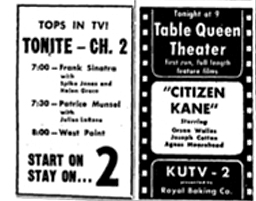 Sarris’s filmographies were packed with titles I’d never heard of. How could I catch up? Around 1955, the studios had begun selling their pre-1948 titles to local television stations. By the next year, people living in major cities could tune in five or six movies a day. At the forefront of TV sales was the financially precarious RKO, which sold over seven hundred titles to an outfit called C & C. C & C packaged the library as 16mm TV prints under the rubric of “Movietime.”
Sarris’s filmographies were packed with titles I’d never heard of. How could I catch up? Around 1955, the studios had begun selling their pre-1948 titles to local television stations. By the next year, people living in major cities could tune in five or six movies a day. At the forefront of TV sales was the financially precarious RKO, which sold over seven hundred titles to an outfit called C & C. C & C packaged the library as 16mm TV prints under the rubric of “Movietime.”
Auteurism owes a good deal to the 1950s-1960s equivalent of home video, the thousands of 16mm prints floating around local TV stations. In Manhattan, WOR-TV screened their films under the rubric “Million Dollar Movie.” The same film might run once or twice every night for a week (and twice or more on weekends). Without benefit of WOR or New York’s revival houses, I was still able to use Rochester television to sample some of the titles that Sarris had listed, especially those given in big caps. (Italicizing must-see items didn’t show up until the book version.) Sarris’s essay, “Citizen Kane: The American Baroque,” was published in Film Culture in 1956, the same year that the RKO library began to be syndicated and Kane was reissued in theatres around the country.
I did wind up subscribing to Film Culture. It was the least I could do to pay them back.
Obligatory autobiography 2
Fall 1965: At a state college up the Hudson, the English department hosted a debate on contemporary American movies. The adversaries were Pauline Kael and Andrew Sarris, both just coming into the national spotlight. One freshman came early and sat with comic earnestness in the front row, a spot he would fetishize later.
Kael was witty and acerbic, tossing off judgments with a wave of her cigarette holder. The Cincinnati Kid was the best of the current crop; Jewison showed great promise. She was riding high because I Lost It at the Movies had come out that spring and was greeted with hosannas. The New Yorker review contrasted her with “the far-out Sarris.”
He didn’t look so far-out. In a crumpled suit, he was resolutely uncharismatic, looking mildly unhappy to be dragged blinking out of the Thalia and shipped upstate. He talked fast, interrupted himself, and, finding few recent movies to praise, celebrated Max Ophuls and Jean Renoir. He delivered enigmatic observations like, “All movies should probably be in color.”
At evening’s end, I knew which camp I belonged in. I got an appropriately nerdy autograph for my Film Culture issue: “Cinecerely yours, Andrew Sarris.” More important, I exulted in a sense that my almost grim obsession with movies had been validated. Not for some time would I realize that I had enlisted, to put it melodramatically, in a fight for American film culture. The battle lines were drawn more sharply in Manhattan than in Albany, but everywhere one thing was clear. Kael was clearly the standard bearer for them, and Sarris was ours.
Obligatory comparison: S vs. K
Who were the them? They were the hip intellectuals who enjoyed a night at the movies. At faculty parties throughout the 1970s I had to check myself when professors of lit or law asked me if I didn’t find Kael’s review that week intoxicating. And she writes so well! As chief New Yorker critic, Kael became the grand tastemaker, a person even filmmakers courted. But who would try to curry favor with the guy who wrote for the Village Voice? It reminds you of the joke about the starlet so dumb she slept with the screenwriter.
Of course like all acolytes we overplayed the differences. Both Kael and Sarris loved classic studio cinema, the performers and scripts as much as the directorial handling. Both critics bemoaned Soviet montage and what they saw as its descendant, the overbusy technique of the 1960s. Both deplored stylistic aggressiveness (the Tony Richardson Syndrome) and both idolized Renoir. Both loved lyricism.
According to us, though, Kael wrote for those who dug movies, while Sarris wrote for those who loved cinema—the medium itself, or rather an exalted idea of the medium’s potential, an ideal form of expression at once dramatic, poetic, pictorial, and musical. He saw each film as bearing witness to the promise of what cinema might be, and he looked in even the tawdriest products for something approximating his dreams. Despite his enthusiasms, he tried for detachment, viewing the latest movie from some unpredictable historical perspective.
Kael famously declared that she watched a new film only once, because that was the way her readers would consume it. But who, we thought, would want to write about a movie after seeing it only once? Mightn’t it reveal some strengths or weaknesses on a second viewing? If it was a good movie, who wouldn’t want to see it more than once? In that same freshman semester, when there were still first-run double features, I sat through The Glory Guys twice in order to watch Help! three times. And that wasn’t even a particularly good movie.
Kael pounced on faults, Sarris savored beauties. Kael made each weak film seem like a blow to her intelligence. Sarris, although he could be harsh, tended to forgive. He taught that it was better to leave a door open than to write someone off—even Bergman, whom some of us would never learn to like until Persona, some not until Fanny and Alexander. Sarris subordinated his personality to that of the movie and its director, which made him seem less fiery than his uptown counterpart; but his attitude suited our own somewhat adolescent amorphousness of character. The arrogant certainty of our tastes was, paradoxically, born of a passionate humility, a sense of serving wise masters named Dreyer, Murnau, Mizoguchi.
Rethinking film history
Sarris is known primarily as the man who gave us the American version of auteurism, or what he called “the auteur theory.” It wasn’t a theory of cinema as such, but rather a heuristic approach to criticism: tips on what to think about and look for when you wanted to plumb a movie’s artistry. But initially, auteurism claimed to be a theory of something else. The opening chapter of The American Cinema is called “Toward a Theory of Film History.”
In Sarris’s day, most people writing about the history of film as an art accepted a notion of technical progress. According to this view, filmmakers became significant by contributing toward the development of the medium. Editing emerged through the efforts of Méliès, Porter, and Griffith, followed by the Russian Montage directors. Various national schools revealed more possibilities of the medium: fantasy and abstraction with the German Expressionists, derangement of sense with the Surrealists.
When sound arrived, a few directors (Clair, Mamoulian, Hitchcock) explored the stylized possibilities of that new technology. But many historians, considering that cinema was inherently a visual medium, declared sound an unwanted intrusion. Clearly, the great days of cinematic artistry were over. Most synoptic histories of the period fell silent about the evolution of technique after the 1920s and concentrate on the emergence of certain genres, such as the musical and the film of social comment.
Even André Bazin could be said to accept the premises of step-by-step artistic progress. Bazin showed that sound cinema wasn’t a dead end, that new artistic possibilities were exploited in the 1930s and 1940s. These were mostly creative alternatives to editing-based technique: the long take, extended camera movement, deep-space staging, and deep-focus cinematography. Bazin claimed that these techniques were most fully on display in the works of Renoir, Wyler, Welles, and some Neorealists.
Sarris was deeply influenced by Bazin’s ideas, but he didn’t accept the conception of film history as an accumulated technical evolution. Sarris called this the “pyramid fallacy,” with each filmmaker adding his slab to the rising and narrowing edifice of cinema. Instead, he proposed thinking of film history as an inverted pyramid, “opening outward to accommodate the unpredictable range and diversity of individual directors.”
In practice this demands that the historian survey entire careers, especially the works of ripe old age. It demands that the historian plot directors’ creative trajectories as paralleling and intersecting and overlapping—perhaps coalescing into broader trends, perhaps creating dead ends. The cinematic universe expands with each new film made, every old film rediscovered or simply re-seen. Auteurism “places a premium on having seen every work by a director who is deemed worthy of a study in depth; and by the time all the cross-references have been pursued in every possible direction auteurism seems to insist that every film ever made is relevant to the inquiry.”
Film history becomes less a linear progress toward something than a vast network of affinities and differences. This idea naturally led Sarris the writer not to the mammoth survey but to multifaceted essay collections. His big book, “You Ain’t Heard Nothin’ Yet,” looks like a panoramic history but is in fact a free-range miscellany, a sort of unbuttoned late-career redo of that Film Culture issue..
You can argue that Sarris was proposing a non-historical history, one that dispenses with concepts of influence and cause and that pulverizes any coherent narrative. That seems to me a valid objection. Despite its claim to be a theory of film history, Sarris’s auteurism strikes me as a historically informed approach to film criticism. The ultimate aim isn’t a convincing historical narrative but a compelling aesthetic judgment. Sarris’s idea of expanding filiation, infinite comparison and contrast, allows him to pursue what matters: evaluation.
In this respect at least, he’s agreeing with his predecessors, the writers who saw history as linear progress. But his criteria of value are different. For the traditionalists, the filmmakers who grasped the next step that the medium should take in its creative development become the best. For Sarris, the best filmmakers used the resources at their disposal to create valuable works that also displayed a distinct conception of human life. “Griffith, Murnau, and Eisenstein had different visions of the world, and their technical ‘contributions’ can never be divorced from their personalities.” Innovation was secondary to expression, and expression could best be gauged by tracking the wayward currents of the history of film style.
Auteur, yes; but of what?
New York Film Festival 1966: Pier Paolo Pasolini, translator, Andrew Sarris, and Agnes Varda. Photo by Elliott Landy. From Film Culture no. 42 (Fall 1966).
The auteur “theory” creates a decentralized and dispersed conception of film history—not a tree with a solid trunk and clear-cut branches but a bristling, tangled bush. The historian will dissolve big changes and broad trends into the doings of particular film artists. Who are these artists? Well, obviously, directors.
This move shouldn’t have been controversial. Critics had long assigned primary creative responsibility to directors. In the 1910s Louis Delluc heaped praise on DeMille and Sjöström, while Griffith was acknowledged around the world as a great innovator. Later von Stroheim, von Sternberg, Eisenstein, Pabst, Clair, Welles, Hitchcock, Maya Deren, and many other filmmakers were recognized as the artistic authority behind their work. In the early 1950s, foreign-language filmmakers such as Kurosawa and Bergman were identified (and even promoted by their distributors) as all-powerful creators saying something through their art.
Sarris’s real innovation was, along with the critics around Cahiers du cinéma and Movie, to transfer the idea of the expressive film artist from the headier regions of art cinema to the jostling, compromised world of Hollywood. There were obvious objections.
*Filmmaking is a “collaborative” activity, so you can’t attribute the final work to a single hand.
Yet in the collaborative medium of opera we speak of a Zeffirelli production as opposed to a Peter Sellars one. Why can’t a film director be a synthesizing artist orchestrating the contributions of many other artists?
*But in opera and other theatre forms, you have a preexisting text, the script or libretto or score. Why isn’t the screenwriter the artist, as Shakespeare or Verdi is?
Because theatrical texts are designed to be instantiated on different occasions, while film scripts are written to be produced only once. The film’s final form includes elements of the script, but that final form, being cinematic, can’t be uniquely specified in verbal language. As we all realize, give the same screenplay to six filmmakers, and you get six different and equally free-standing films.
*Popular film can’t be compared to high art. Artistry demands control, and the novelist, the painter, and even the opera director will exercise complete control over the final work. A Bergman or Antonioni has the cultural clout to dictate every aesthetic effect, but the Hollywood filmmaker works as part of a larger process controlled by others. He is handed a script and shoots it, and not necessarily all of it; second-unit and visual effects staff have their input too. The producer may demand more close-ups. In the classic studio system, the director wouldn’t typically get final cut; the producer would shape the released film. All these conditions constitute barriers to artistic expression. The auteur theory, when applied to Hollywood, is deeply inappropriate.
One answer to this objection is that many directors, including some of the best ones, did have a good deal of control over their work: Hitchcock, Hawks, and others were their own producers and worked on their scripts and oversaw their post-production. Moreover, a director can control choices down the line in sneaky ways, as when Ford shot his films so that they could be assembled in only one way.
Sarris advanced another reply to the control objection. If it owed something to the Cahiers young critics, he articulated and practiced it more keenly than they. He proposed a critical method: Take as many films signed by the director as you can find. Attend to the way they exercise their craft, the way they tell their stories and convey their meanings. Seek out an expressive core that seems distinctive, even unique.
Most directors’ collected works won’t yield this. “Not all directors are auteurs. Indeed, most directors are virtually anonymous.” Only the best directors will display a distinct expressive quality. Hawks and Hitchcock evoke radically different worlds of action and feeling, just as Mozart and Rembrandt can.
Fifteen years after his initial statement on the matter, “Notes on the Auteur Theory in 1962,” Sarris suggested that the elusive concept of personality was not to be derived from the director’s biography. “I was never all that interested in the clinical ‘personalities’ of directors. . . . A director’s formal utterances (his films) tell us more about his artistic personality than do his informal utterances (his conversation).”
For example, we understand John Ford’s respect for what Sarris calls “codes of conduct” not through the old curmudgeon’s interviews but by confronting the tangible texture of the movies. One of Sarris’s favorite examples occurs in The Searchers. Drinking his coffee, the Ward Bond character glances toward the wife of the household. Then his point of view reveals her stroking the uniform of her husband’s brother, played by John Wayne.
Cut back to Bond as the wife and her brother-in-law meet for a tender farewell. Bond stares off into space, chewing.
“Nothing on earth,” writes Sarris, “would ever force this man to reveal what he had seen. There is a deep, subtle chivalry at work here, and in most of Ford’s films, but it is never obtrusive enough to interfere with the flow of the narrative.” The economy is part of the point. “If it had taken him any longer than three shots and a few seconds to establish this insight into the Bond character, the point would not be worth making.”
In the Hollywood studio context, there was something heroic about the rare director who could surmount all the pressures, filter out all the noise, and shape the impact of his work. “The auteur theory values the personality of the director precisely because of the barriers to its expression.” Like a great Renaissance painter paid by a pope or a duke and pledged to illustrate well-known stories, the Hollywood director working for a studio could occasionally conjure up something powerful and distinctive.
Auteurism, Sarris claimed, is our straightest road to determining a film’s value. The great films, by and large, will be those that evoke distinctive directorial sensibilities. But “by and large” allows for the possibility of excellent movies that we can attribute to other forces—script, stars, source material, the happy intersection of talents. Casablanca, writes Sarris, “is the most decisive exception to the auteur theory.” Sarris loved movies more than he loved his theories.
Compare, contrast, repeat
Sarris’s breakthrough essay, “Citizen Kane: The American Baroque,” appeared in Film Culture during the 1956 revivals of the film. This detailed explication, published when Sarris was twenty-eight, betrays his grad-school training at a period when the New Criticism reigned. In a single stroke, he pioneered the sort of close reading that would become central to Anglo-American academic film criticism.
I can’t recall any later Sarris essay offering such an intensive analysis of a single film. As he developed his historically-guided critical appraisals, he favored synoptic appreciations of directorial careers. These became the occasions for him to point out interacting directorial personalities that comprise that vast network of cinema.
Instead of macro-analysis, Sarris embraced a strategy of “drilling down,” we’d now say, to a single revelatory passage. The chief tactic is comparison, often involving two directors faced with a comparable situation. Both City Lights and The Goat show a protagonist hiding on a statue about to be unveiled. Chaplin seizes the chance to deflate the ceremony.
But Keaton, says Sarris, is less interested in satire; he is “a pessimist in perpetual motion.” In The Goat, “Keaton remains mounted on the clay horse until it begins to sag and crumple under his weight, and the sculptor, a bearded nincompoop in a beret, proceeds to break down and weep.”
“Keaton’s expression here,” Sarris claims, “is mercilessly pragmatic. What good is a clay horse (art?) if you can’t mount it to your own advantage? There is something unabashedly ruthless about Keaton’s comedy, which chills his humor.” This was the period when critics, having just rediscovered Keaton’s films, claimed him as a “metaphysician.” Sarris likened him to Beckett.
Sarris wasn’t alone in turning to detailed commentary at the period; we had Dwight Macdonald’s appreciative 1964 essay on 8 ½ and John Simon’s book-length study of Bergman (1973). But Sarris got there early with the Kane piece, and throughout his career he used analysis to pinpoint authorial personality. Attention to nuanced differences allowed him to create a kind of connoisseurship.
The ultimate expression of this connoisseurship emerges in his concern for privileged moments. A critic has to be alert for shots or gestures or lines of dialogue that encapsulate the emotional tenor of a film and a director’s sensibility. Sarris’ example is a moment in La règle du jeu:
Renoir gallops up the stairs, stops in hoplike uncertainty when his name is called by a coquettish maid, and then, with marvelous post-reflex continuity, resumes his bearishly shambling journey to the heroine’s boudoir.
If I could describe the musical grace note of that momentary suspension, and I can’t, I might be able to provide a more precise definition of the auteur theory. As it is, all I can do is point at the specific beauties of interior meaning on the screen and later catalogue the moments of recognition.
No director but Renoir, Sarris suggests, would have Octave break the scene’s rhythm in exactly this way–and in a manner, Sarris’s bear-metaphor hints, that anticipates Octave’s costume for the climactic party in the chateau. The nonchalant, slightly awkward interruption epitomizes Renoir’s entire style of filmmaking, which has room for casual deflections from neat plotting and groomed performances. The critic’s words can’t wholly capture the force of Octave’s hop, and its resonance for Renoir’s film and his oeuvre. It is, says Sarris, “imbedded in the stuff of cinema.”
Both cinephiles and ordinary viewers are seized by luminous instants that change our skin temperature. We come out of a film satisfied if a few epiphanies have flashed upon us. The critic can signal them but not explain them fully. Interior meaning is the product of craft and personality, but it can’t be reduced to them. It creates a tingling, fugitive beauty that is unique to cinema.
Everyone has his or her own Sarris. The foregoing offers merely bits of mine, and they’re largely academic in slant. That’s because I think that Sarris changed, among other things, the way film history and criticism were taught in American universities. While Kael influenced film journalism, particularly in the upscale markets, Sarris’s legacy is best seen in cinephile criticism (Film Comment, Film Quarterly et al.) and academic film studies. Some Paulettes went to work for the New York cultural weeklies, high and low. Many people who were Sarrisites to some degree (Jeanine Basinger, James Naremore, John Belton, William Paul, Elisabeth Weis, Chuck Wolfe, Mark Langer, Robert Lang, et al.) became professors. Kael’s followers turned out essays, but Sarrisites like Todd McCarthy and Joseph McBride wrote books based firmly in research. Sarris’s version of auteurism has been reworked, in plenty of intriguing ways, in directorial monographs from university presses. He once remarked ruefully that he was an academic among journalists and a journalist among academics, but he managed to bridge the gap adroitly.
Sarris was too far-out for the New Yorker in 1965, and probably for the New Yorker of today. But history, and not just the history of movies, was on his side.
Sarris’ life and death have called forth many eloquent tributes. Among the best are Kent Jones’ career overview, Richard Corliss’s moving memoir, and Jim Emerson’s calm discussion of the excesses of the Sarris vs. Kael dichotomy. See also Ben Kenigsberg’s memories of Sarris’s teaching style.
My quotations are taken from Film Culture no. 28 (Spring 1963), The American Cinema (Dutton, 1968), Confessions of a Cultist: On the Cinema, 1955/1969 (Simon and Schuster, 1971), The Primal Screen (Simon & Schuster, 1973), and The John Ford Movie Mystery (Secker & Warburg, 1976). Thanks also to email conversations with John Belton of Rutgers and Dennis Bingham of Indiana University.
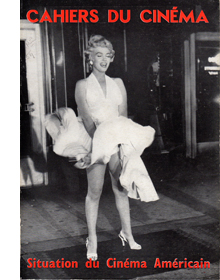 When I received Film Culture no. 28, I didn’t know that it represented a continuation of a Cahiers du cinéma tradition. In December 1955, the journal had published a special issue, “Situation du Cinéma Américain” (no. 54). It included not only critical essays but a “dictionary” of contemporary American directors: small-print filmographies followed by a paragraph of lapidary commentary. (“Lang’s work is founded on a metaphysics of architecture.”) Later issues devoted “dictionaries” to current French cinema (no. 71, May 1957), the Nouvelle Vague (no. 138, December 1962), and more recent American cinema (no. 150-151, December 1963-January 1964). In his American Cinema project, Sarris altered the format significantly by expanding the commentaries into essays and then grouping directors within sharp-edged, highly memorable categories of value. In turn, Sarris’s catalogue seems to have been the model for Martin Scorsese’s “Personal Journey through American Movies.” In the same tradition is Jean-Pierre Coursodon and Pierre Sauvage’s too-little-known American Directors (1983).
When I received Film Culture no. 28, I didn’t know that it represented a continuation of a Cahiers du cinéma tradition. In December 1955, the journal had published a special issue, “Situation du Cinéma Américain” (no. 54). It included not only critical essays but a “dictionary” of contemporary American directors: small-print filmographies followed by a paragraph of lapidary commentary. (“Lang’s work is founded on a metaphysics of architecture.”) Later issues devoted “dictionaries” to current French cinema (no. 71, May 1957), the Nouvelle Vague (no. 138, December 1962), and more recent American cinema (no. 150-151, December 1963-January 1964). In his American Cinema project, Sarris altered the format significantly by expanding the commentaries into essays and then grouping directors within sharp-edged, highly memorable categories of value. In turn, Sarris’s catalogue seems to have been the model for Martin Scorsese’s “Personal Journey through American Movies.” In the same tradition is Jean-Pierre Coursodon and Pierre Sauvage’s too-little-known American Directors (1983).
For more on C & C, which was a soda-pop company, go here. By 1956, WOR-TV was owned by the same company that owned RKO, so it’s no surprise that Kane, King Kong, and other items from the Movietime package played ceaselessly on that station. WOR’s radio station intersected my life from another angle.
For more on the standard version of the history of film art, along with Bazin’s revision of it, see my On the History of Film Style.
The homage volume, Citizen Sarris: American Film Critic, includes many fine pieces, but please don’t read my contribution. Editorial carelessness has mangled it beyond recognition. The version I’ll stand by, “Cinecerity,” is available in my Poetics of Cinema. Portions of this blog entry are lifted from that essay, but I’ve omitted most of my discussion of Sarris’s conception of film style.
New York Film Festival, 1966: Nat Hentoff, Pauline Kael, Parker Tyler, Arthur Knight, Judith Crist, Hollis Alpert, Andrew Sarris. Photo by Elliott Landy. From Film Culture no. 42 (Fall 1966).
PS 24 June 2012: More moving commentary in memoriam at the Film Comment site.
COGNITIVISTS STORM BIG APPLE! BIG APPLE ASKS, “WHAT’S A COGNITIVIST?”
The final SCSMI 2012 banquet, held on the tenth floor of the NYU Kimmel Center for University Life, Rosenthal Pavilion.
DB here:
Most years I offer an entry recording some events at the annual meeting of the Society for Cognitive Studies of the Moving Image. We did hold our conference–and a swell one it was, starting Wednesday at Sarah Lawrence College and wrapping up at the Cinema Studies department of New York University last Saturday. I heard many excellent papers and panel discussions. (The schedule is on a pdf here.) The event was also graced by keynote lectures by Alva Noë and Noël Carroll, and a night of splendid, eye-warping films by Ken Jacobs, no stranger to this blog (here and here and here). Malcolm Turvey of Sarah Lawrence and Richard Allen of NYU did an excellent job of coordinating the SCSMI event.
But I can’t offer my usual conference roundup this time. Kristin and I just got back last night, and we have only three days in Madison before taking off for Il Cinema Ritrovato. In those three days we have a hell of a lot to do, including setting me up for Medicare (!), as I’ll turn 65 during our trip. But I did want to supplement a small runup piece to the conference a couple of weeks back.
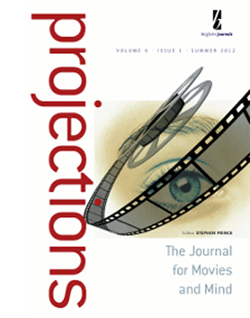 A few days after that post, I received the most recent issue of Projections, a journal with which SCSMI is affiliated. It’s stuffed with worthwhile pieces: Gerald Sim’s overview of the digital revolution (if any) in cinematography; Barbara Flueckiger’s essay, “Aesthetics of Stereoscopic Cinema”; Mark J. P. Wolf’s study of imaginary worlds on film; and James E. Cutting, Kailin L. Brunick, and Jordan DeLong’s correction of one claim they made about shot lengths and film acts. (Kristin discusses their project in this entry from last year.)
A few days after that post, I received the most recent issue of Projections, a journal with which SCSMI is affiliated. It’s stuffed with worthwhile pieces: Gerald Sim’s overview of the digital revolution (if any) in cinematography; Barbara Flueckiger’s essay, “Aesthetics of Stereoscopic Cinema”; Mark J. P. Wolf’s study of imaginary worlds on film; and James E. Cutting, Kailin L. Brunick, and Jordan DeLong’s correction of one claim they made about shot lengths and film acts. (Kristin discusses their project in this entry from last year.)
As if all this weren’t enough, the issue includes a lively and probing roundtable on Continuity Editing, with a superb synoptic article by Tim Smith summing up his eye-tracking research. (His study of There Will Be Blood is our now-classic guest blog.) Tim’s article is an ideal introduction to his wide-ranging research program. Several other scholars comment on Tim’s “attentional theory of continuity editing”: Paul Messaris, Cynthia Freeland, Sheena Rogers, Malcolm Turvey, Greg Smith, and Daniel T. Levin and Alicia M. Hymel. Tim replies to their criticisms in a follow-up piece. This sort of dialogue occurs very rarely in film studies, and it’s to be applauded. I think such serious and courteous exchanges are the mark of a mature, or at least maturing, discipline.
You can learn more about Projections here and read a sample issue here. If your library doesn’t subscribe, maybe you can hint that it should. Although it’s hard to determine the image format of the swirling filmstrip on the cover (image ratio and perfs are puzzling), note that at least it is film.
I learned so much from this year’s get-together that you shouldn’t be surprised if pieces of it float into upcoming blog entries. And in 2013, there’s always Berlin.
From Sam Wass, Parag Mital, and Tim Smith’s paper, “Cutting through the blooming, buzzing confusion: Signal-to-noise ratios and comprehensibility in infant-directed screen media.”
I Love a Mystery: Extra-credit reading
Thornton Utz illustration for Rex Stout novella from American Magazine, 1951. Obtained from the excellent site Today’s Inspiration.
DB here:
Over the next few months, I’ll be traveling with a talk on Hollywood cinema of the 1940s. The ideas I’ll propose are destined for a book about narrative norms during that period. Mystery fiction is important to that lecture, but I don’t have room there to supply much background about the relevant conventions. So I’m sketching in this background here, for people who might hear the talk somewhere or who might just be curious. Consider this as another experiment on the blog, using the web to supplement a lecture.
Although the lecture is mostly about cinema, this entry is mostly about novels and plays. But I’ll mention film here and there, and you’ll notice that some of the books and plays I mention were adapted for the screen.
A mega-genre
The first half of the twentieth century saw an explosive expansion in genres built around mystery and suspense. The most obvious genre is the detective story. In the wake of Conan Doyle’s Sherlock Holmes tales, a great many writers developed and elaborated on the idea of the master sleuth, the genius of observation and reason. Central to this tradition was the puzzle that could be solved by careful noting of clues and meticulous reasoning about them, supplemented by a good knowledge of human nature or local customs. The author needs to keep us in the dark about both the crime and the detective’s chain of reasoning; hence point-of-view figures like Watson, who can be appropriately confounded, relay the detective’s cryptic hints, and marvel at the final revelations.
Readers quickly learned the conventions, so writers had to innovate constantly. Sometimes a writer was original on more than one front. For example, R. Austin Freeman created a revamped Holmes surrogate in a scientific criminologist, Dr. Thorndyke, while also creating a new narrative structure: that of the “inverted” tale. The first section of the story follows the criminal who commits the crime; the second part details how Thorndyke, using evidence and inference, solves it.
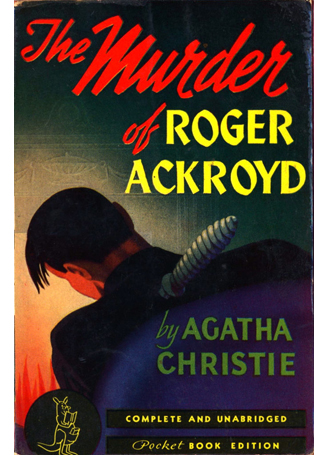 Historians of the detective story have a standard account that goes like this. The puzzle-centered plot developed to its apogee in the 1920s and 1930s, chiefly in Britain, and was picked up in the United States. In books like The Murder of Roger Ackroyd (Agatha Christie, 1926), The Canary Murder Case (S. S. Van Dine, 1927), The Unpleasantness at the Bellona Club (Dorothy L. Sayers, 1928), The Poisoned Chocolates Case (Anthony Berkeley, 1929), The Egyptian Cross Mystery (Ellery Queen, 1932), and The Crooked Hinge (John Dickson Carr, 1938), the crimes are deeply puzzling, even fantastical, and the solutions ever more recherché.
Historians of the detective story have a standard account that goes like this. The puzzle-centered plot developed to its apogee in the 1920s and 1930s, chiefly in Britain, and was picked up in the United States. In books like The Murder of Roger Ackroyd (Agatha Christie, 1926), The Canary Murder Case (S. S. Van Dine, 1927), The Unpleasantness at the Bellona Club (Dorothy L. Sayers, 1928), The Poisoned Chocolates Case (Anthony Berkeley, 1929), The Egyptian Cross Mystery (Ellery Queen, 1932), and The Crooked Hinge (John Dickson Carr, 1938), the crimes are deeply puzzling, even fantastical, and the solutions ever more recherché.
It’s hard for us to conceive today how massively popular these puzzle books were. Van Dine’s first novels were bestsellers comparable to Jonathan Kellerman’s books today. Just as important, the detective story was granted quasi-literary status. Magazines and newspapers that wouldn’t dream of reviewing romance or adventure fiction devoted space to detective stories, sometimes even setting up separate columns or sections for reviews. It was believed, rightly or wrongly, that whodunits had a more intellectual readership than Westerns or science fiction.
At about the same time, according to the standard account, a counter-current was swelling. In the pulp magazines of the 1920s, the “hard-boiled” detective emerged as an alternative to the master sleuth. The prototype is Dashiell Hammett’s Continental Op in stories through the late 1920s, to be followed by Sam Spade in The Maltese Falcon (1930). Strikingly, Hammett and other hard-boiled writers don’t wholly abandon the basic idea of solving a mystery through some sort of reasoning. The differences have to do with realism. The crimes, however, aren’t usually fantastical ones like the Locked-Room problem; the killings tend to be mundane. If the white-glove detective’s only real opponent is a master criminal like Professor Moriarty, the hard-boiled detective faces off against organized crime, or at least people who commit murder outside upper-crust parlors and remote country houses. Clues are less likely to be physical, and more psychological, depending on bits of behavior or flashes of temperament. Raymond Chandler and others took the hard-boiled initiative into the 1940s, and the brute detective, who solves crimes with boldness, insolence, and a pair of fists, occasionally supplemented by torture, found bestseller status in Mickey Spillane’s I, the Jury (1947) and subsequent novels.
I’d argue that some writers could blend the master-mind detective and the tough guy. Erle Stanley Gardner’s Perry Mason was one such hybrid, though leaning closer to the hard-boiled model. Rex Stout solved the problem neatly by creating two detectives: the insolent legman Archie Goodwin serves as a hard-boiled Watson to sedentary Nero Wolfe. But on the whole, historians tend to assume that the Holmesian superman and the puzzle-dominated plot were swept aside by the rise of the tough-guy detective solving mysteries that were grittier and more “realistic” than what had preoccupied Golden Age writers.
Two other major developments are typically highlighted by historians. There was the police procedural, perhaps initiated by Lawrence Treat’s V as in Victim (1945), and explored with great ingenuity in the novels of Ed McBain. There was also what Julian Symons has called the “crime novel,” the story of psychological suspense, with Patricia Highsmith’s Strangers on a Train (1950) serving as a good example. Both of these genres have proven popular to this day (CSI as a procedural, the films of De Palma as psychological thrillers).
A tree and its branches
Like most histories hovering fairly far above the ground, the standard account traces some main contours of the landscape but misses some interesting byways. By taking Doyle as the prototype, this account tends to identify mystery fiction with detective plots in the Holmes mold. But mysteries come up in other forms.
The standard account has trouble accommodating the development of the spy genre, which often involves solving a crime, but less through abstract reasoning than by putting the hero through hairbreadth adventures. Think for instance of The 39 Steps, both the 1915 novel and the 1935 film.
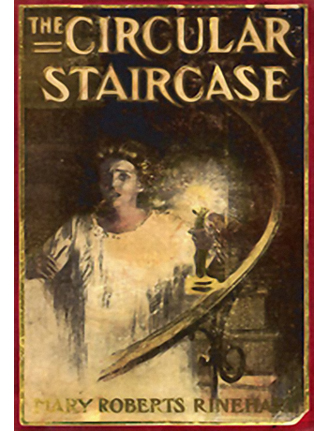 More seriously, by identifying solving mysteries with the activities of professional, overwhelmingly male, detectives historians have neglected the powerful and popular tradition of the revived Gothic or “sensation” novel of the mid-nineteenth century. This is typified by Wilkie Collins’ Woman in White (1859-1860) as much as by The Moonstone (1868), often considered the first detective novel (largely because a detective figures as one of the characters, even though he doesn’t solve the mystery). Collins’ novels, along with those of Mary E. Braddock, updated the Gothic format through more complex plotting and multiple points of view. In the next century, Mary Roberts Rinehart, with The Circular Staircase (1908), has to be considered as important as Freeman. Rinehart’s plot introduces the crucial conventions of the mysterious house, the curious and brave woman who explores it, and the threats lurking behind placid domesticity. While the classic white-glove sleuth isn’t usually in much danger, The Circular Staircase and other updated sensation novels make the investigating figure a woman in peril. The sensation novel replaces cool rationality with fear and desperation.
More seriously, by identifying solving mysteries with the activities of professional, overwhelmingly male, detectives historians have neglected the powerful and popular tradition of the revived Gothic or “sensation” novel of the mid-nineteenth century. This is typified by Wilkie Collins’ Woman in White (1859-1860) as much as by The Moonstone (1868), often considered the first detective novel (largely because a detective figures as one of the characters, even though he doesn’t solve the mystery). Collins’ novels, along with those of Mary E. Braddock, updated the Gothic format through more complex plotting and multiple points of view. In the next century, Mary Roberts Rinehart, with The Circular Staircase (1908), has to be considered as important as Freeman. Rinehart’s plot introduces the crucial conventions of the mysterious house, the curious and brave woman who explores it, and the threats lurking behind placid domesticity. While the classic white-glove sleuth isn’t usually in much danger, The Circular Staircase and other updated sensation novels make the investigating figure a woman in peril. The sensation novel replaces cool rationality with fear and desperation.
Jane Eyre is an obvious source for Rinehart and her successors, and perhaps the association with women’s writing in general made historians and practitioners of the Golden Age mock the revived Gothic as too feminine, too far removed from the bluff masculine camaraderie of 221 B Baker Street. The Gothicists had their revenge: Daphne Du Maurier’s Rebecca (1938) outsold every other mystery novel of its time and sustained a cycle of new sensation novels by Mabel Seeley (The Chuckling Fingers, 1941), Charlotte Armstrong (The Chocolate Cobweb, 1948), and Hilda Lawrence (The Pavilion, 1946). The genre is maintained today by Mary Higgins Clark, Nicci French, and many other writers.
So mystery and detection formed a broader tradition than literary historians sometimes acknowledge. Another marginal form was the suspense thriller. Again, we can point to a woman: Marie Belloc Lowndes, author of The Lodger (1913). An early instance of the serial-killer plot, it’s also a tour de force of point-of-view; unlike the film versions, it restricts itself quite rigorously to what certain secondary characters know. Choices about narration and viewpoint are no less crucial to the thriller than to the Great Detective tradition.
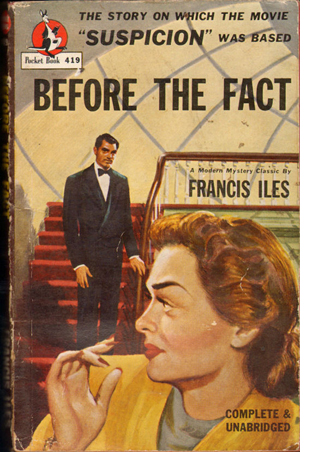 The psychological thriller was revived during the Golden Age, sometimes by practitioners of the puzzle-story. Anthony Berkeley Cox, writing as Anthony Berkeley, noted in The Second Shot (1930):
The psychological thriller was revived during the Golden Age, sometimes by practitioners of the puzzle-story. Anthony Berkeley Cox, writing as Anthony Berkeley, noted in The Second Shot (1930):
I personally am convinced that the days of the old crime puzzle pure and simple, relying entirely upon plot, and without any added attractions of character, style, or even humour, are, if not numbered, at any rate in the hands of the auditors. . . The puzzle element will no doubt remain, but it will become a puzzle of character rather than apuzzle of time, place, motive, and opportunity. The question will be not “Who killed the old man in the bathroom?” but “What on earth induced X, of all people, to kill the old man in the bathroom?”
Cox went on to test his premises in Malice Aforethought (1931) and Before the Fact (1932). Both trace the schemes of wife-killers, but the first novel is told from the husband’s standpoint and the second from the wife’s. The latter book opens:
Some women give birth to murderers, some go to bed with them, and some marry them. Lina Aysgarth had lived with her husband for nearly eight years before she realized that she was married to a murderer.
There followed other domestic-crime psychological novels, notably Richard Hull’s The Murder of My Aunt (1934).
Sometimes suspense thrillers have a solid mystery at their center; this is common when the protagonist is a potential victim. Other thriller plots in effect present the first half of a Freeman “inverted” story, concentrating on the criminal’s execution of a crime and the resulting efforts to escape punishment. Both possibilities were on display in British stage plays of the 1920s and 1930s. In a sense Cox was beaten to the punch by Rope (1929), Blackmail (1929), and Payment Deferred (1931). Later examples are Night Must Fall (1935) and the woman-in-peril dramas Kind Lady (1935) and Gaslight (1938). Many of these plays were made into films.
The novel of suspense really came into its own in the 1940s, when it started to incorporate abnormal psychology. Patrick Hamilton, author of Rope and Gaslight, provided an influential novel as well, Hangover Square (1941). Cornell Woolrich and David Goodis, who mined this nightmarish vein, achieved posthumous cult status because, again, of the spell of film noir. Other suspenseful students of mania were Dorothy B. Hughes (In a Lonely Place, 1947), Charlotte Armstrong (The Unsuspected, 1945; Mischief, 1951, filmed as Don’t Bother to Knock), and Elizabeth Sanxay Holding (The Blank Wall, 1947, source of The Reckless Moment). Chandler called Sanxay Holding “the top suspense writer of them all.” We shouldn’t ignore the influence of Simenon’s romans durs, which were being translated and respectfully reviewed throughout the war years.
Yet another new wrinkle on the mystery thriller was the genre of courtroom novels. The Bellamy Trial (1927), which begins when the trial does and restricts itself almost completely to what transpires in the courtroom, popularized the pattern. Stage plays of the 1920s adopted the pattern too. The format proved irresistible for early talkies, as in adaptations of The Bellamy Trial (1929) and Thru Different Eyes (1929) and the radio-inspired Trial of Vivienne Ware (1932). Cox, who seemed to try his hand at every current trend, gave his own twist to the juridical mystery in Trial and Error (1937).
Most of these novels focused on the trial proceedings from the perspective of the defendant, but a few concentrated on those sitting in judgment. The Jury (1935), by Gerald William Bullett, characterizes the jurors singly before they gather and then shows the trial from their standpoints before taking us into the jury room to hear the arguments. Bullett’s novel finds an equally engrossing complement in Raymond Postgate’s Verdict of Twelve (1940). There were also Eden Philpotts’ The Jury (1927) and George Goodchild and C. E. Bechhofer Roberts’ The Jury Disagree (1934). We can immediately recognize the teleplay and film Twelve Angry Men as an updating of this minor line.
Merging and markets
The family tree of mystery, then, grew many branches in the 1920s and 1930s—the pure puzzle, the hard-boiled investigation, the spy story, the revised Gothic or sensation novel, and the suspense thriller, often of a psychological cast. Unsurprisingly, the genres began to mingle. Cox was perhaps the writer most interested in hybrids, but John Dickson Carr tried his hand at the thriller as well (The Burning Court, 1937), as did Agatha Christie in And Then There Were None (aka Ten Little Indians, 1940).
The process sped up during the 1940s, when writers began blending crime-solving with psychological suspense. We can get a sense of how the protagonist-in-peril side of the thriller melded smoothly with the enigma-based investigation by looking at the jacket copy of a fairly ordinary entry, Alarum and Excursion (1944):
Bit by bit, a gesture here, a sound there, Nick Matheny pieced together the awesome puzzle of the accident that had sent him to a sanitarium with traumatic amnesia. One by one he reconstructs, he probes the cirumstances of the explosion in his factory, the disappearance of his weak but beloved son, his wife’s strange attitude toward the new management of the business, and the status of the new synthetic fuel formula, which was so urgently needed.
As the dreadful picture unfolds itself, Nick escapes from the sanitarium to ferret out the sinister changes that have disrupted his business and brought his active life to an abrupt close.
Virginia Perdue, author of He Fell Down Dead, skillfully handles the difficult flash backs in this unusual psychological drama. There are many scenes where the tricks of thought, the tenseness of apprehension, the visions through the deserted streets of blacked-out memory poignantly work their stealth upon the mind of the reader.
Alarum and Excursion wasn’t adapted into a film, but reading this spoiler-filled jacket copy you can easily imagine the movie.
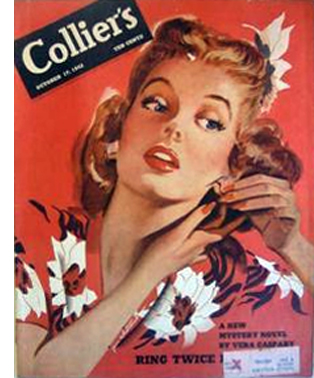 One more factor needs to be mentioned: the publication venues. Everybody knows that the hard-boiled tradition has its roots in Black Mask and other pulp magazines of the 1920s. What’s less often emphasized is the “slick-paper” market of the 1930s and 1940s. The Saturday Evening Post, Ladies’ Home Journal, Good Housekeeping, Cosmopolitan (rather different from what it is now), The American Magazine, and many other weekly magazines ran a great deal of fiction, both short stories and serialized novels. The high-paying slick market showcased soft-boiled mysteries involving Perry Mason and Nero Wolfe and welcomed suspense fiction too. Major suspense authors of the 1940s, such as Charlotte Armstrong and Vera Caspary, would garner tens of thousands of dollars in serialization rights. On the right is the cover of Collier’s for 17 October 1942, announcing the first installment of Ring Twice for Laura, later known simply as Laura.
One more factor needs to be mentioned: the publication venues. Everybody knows that the hard-boiled tradition has its roots in Black Mask and other pulp magazines of the 1920s. What’s less often emphasized is the “slick-paper” market of the 1930s and 1940s. The Saturday Evening Post, Ladies’ Home Journal, Good Housekeeping, Cosmopolitan (rather different from what it is now), The American Magazine, and many other weekly magazines ran a great deal of fiction, both short stories and serialized novels. The high-paying slick market showcased soft-boiled mysteries involving Perry Mason and Nero Wolfe and welcomed suspense fiction too. Major suspense authors of the 1940s, such as Charlotte Armstrong and Vera Caspary, would garner tens of thousands of dollars in serialization rights. On the right is the cover of Collier’s for 17 October 1942, announcing the first installment of Ring Twice for Laura, later known simply as Laura.
As mystery genres proliferated, their popularity soared. Contrary to what historians imply, the puzzle novel with a brilliant sleuth was far from defunct. Christie’s Poirot and Sayers’ Wimsey retained their fame into the 1940s, significantly outselling Hammett and Chandler. Ellery Queen’s novels are not read much today, so it’s hard to imagine a time when over a million copies of them were in print. More generally, the public’s appetite for mystery novels and radio plays was intense. In 1940, 40 % of all titles published were mysteries, and in 1945, an average four radio shows devoted to mystery were broadcast every day, each drawing about ten million listeners.
Small wonder, then, that Hollywood came calling. Curiously, the master detectives popular with the reading public wound up in B-film series (Charlie Chan, Ellery Queen) or remained unexploited in the 40s (Nero Wolfe, Perry Mason). What came to the fore, as being more suitable for the dynamic medium of film, were the hard-boiled heroes of Hammett and Chandler. Because the rise of hard-boiled adaptations fed clearly into film noir, they have attracted the most attention. But mutating alongside them, and becoming at least as lucrative, were the films shaped by the updated Gothic and the psychological thriller. Variety noticed the trend in fall of 1944.
Plain murder as a film frightener is passé. Been done too long in the same old way. Theatregoers actually can yawn in the face of manslaughter as it’s been perpetrated for the whodunits during the past year or more. . . . The newer type of horror pictures, invested with psychological implications, deal with mental states rather than melodramatic events. . . . The typical tale in the new genre crawls with living horror, is eerie with something impending, and socks its suspense thrill well along toward the middle of the story instead of doing the crime victim in at the beginning and then building a whodunit and a detective quiz as the element of suspense.
The piece doesn’t respect today’s genre distinctions. Apart from using the term “horror” in a way we wouldn’t, the author lumps together suspense thrillers like The Lodger, Hangover Square, The Uninvited, and The Suspect; the Gothic Gaslight (“a perfect example of the new approach”); and spy thrillers The Mask of Dimitrios and The Ministry of Fear. Even Jane Eyre is included, without irony. (Surprisingly, Double Indemnity from spring 1944 isn’t mentioned.) Still, the article acknowledges that mystery had strong audience appeal and that while the classic whodunit had had its day on the movie screen, films could be given new energy by other literary trends.
Mystery as artifice
Mystery is the only genre I know that makes narrative strategies as such central to its identity. A musical, a Western, or a science-fiction saga can be presented in linear fashion, telling us everything step by step, and still retain a genre identity. But a mystery plot can’t be presented straightforwardly. The writer must manipulate plot structure and narration to some degree.
A mysterious situation or plot action is one whose causes are to some degree unknown. In the detective formula, both refined and hard-boiled: A person has been murdered; what led up to it? In the Gothic: There are sinister goings-on in the house; what’s causing them? In the suspense thriller: Someone wants to harm me; who and why? (And will I escape?) To generate mysteries, the plot-maker must suppress key information. That can be done by opening late in the story (say, after the crime has been committed), by employing flashbacks (often launched from a climactic moment), or by restricting the range of knowledge (via a Watson or a string of eyewitnesses). More subtle options involve ellipses, such as those in The Murder of Roger Ackroyd and the diary portion of The Beast Must Die (1938).
At the level of prose style, clues can be buried in descriptions or offhand remarks. The narration can creatively mislead us from the start, in the title (The Murder of My Aunt, The Murderer Is a Fox) or the diabolical opening sentence of Carr’s “The House in Goblin Wood.” And sometimes you get pure showing off. The first chapter of The Rynox Murder Mystery (1931) is entitled “Epilogue,” and the last chapter is entitled “The Prologue.” In addition, the book is broken not into parts and chapters but “reels” and “sequences,” a device creating a small meta-mystery (gratuitously, so far as I can tell.)
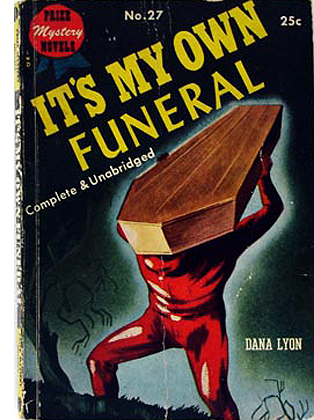 Given the proliferation and mixing of genres and the constant demand for innovation (echoed in Variety’s crack about things “being done too long in the same old way”), 1940s mystery writers were pressed to find new storytelling gimmicks. Everything had not been done, at least not yet. Historians of the detective story routinely praise the ingenuity of Christie and company in the 1930s, but the 1940s saw a positively baroque expansion of options. A dead detective pursues the investigation as a ghost. Another wakes up trapped in a coffin and starts telling us how he got there. Pat McGerr distinguished her work by replacing the question Whodunit? with others, such as: We know who’s guilty, but who’s been murdered?
Given the proliferation and mixing of genres and the constant demand for innovation (echoed in Variety’s crack about things “being done too long in the same old way”), 1940s mystery writers were pressed to find new storytelling gimmicks. Everything had not been done, at least not yet. Historians of the detective story routinely praise the ingenuity of Christie and company in the 1930s, but the 1940s saw a positively baroque expansion of options. A dead detective pursues the investigation as a ghost. Another wakes up trapped in a coffin and starts telling us how he got there. Pat McGerr distinguished her work by replacing the question Whodunit? with others, such as: We know who’s guilty, but who’s been murdered?
In the suspense mode as well, we find efforts to create novelty at the level of narration. With the emerging interest in psychoanalysis, the thriller began to probe the protagonist’s inner life and hidden traumas, producing not only the hallucinatory visions of Woolrich and Goodis but the crazy-lady divagations seen in The Snake Pit (1947), Devil Take the Blue-Tail Fly (1948), and Patricia Highsmith’s early short story, “The Heroine” (1945). As in the purer tale of detection, a great deal depended on feints and fake-outs at the level of the prose. The cleverly misleading narration of Ira Levin’s A Kiss Before Dying (1953) turns on the use of a pronoun.
Hollywood filmmakers borrowed plentifully from the new genres, particularly the psychological thrillers that could appeal to women. Significantly, Rinehart’s pioneering 1908 novel was remade as The Spiral Staircase (1945), and Warner Brothers redid Collins’ classic Woman in White in 1948. Moreover, I think, filmmakers tried to find cinematic counterparts for the genre’s restricted narration, dream and fantasy passages, misleading exposition, and shrewd ellipses (e.g., Possessed, 1947; Mildred Pierce, 1945; Fallen Angel, 1945). The diversity of mystery fiction inspired Hollywood writers and directors to create a Golden Age of the mystery film, and the innovations of the period left a legacy for filmmakers ever since.
These genres had a wider impact too. That’s what I’ll concentrate on in my presentation, “I Love a Mystery: Narrative Innovation in 1940s Hollywood.”
The two major histories of mystery fiction are Howard Haycraft, Murder for Pleasure: The Life and Times of the Detective Story (1941) and Julian Symons, Mortal Consequences: A History from the Detective Story to the Crime Novel (1972). Both are very much worth reading, as is Leroy Lad Panek’s idiosyncratic An Introduction to the Detective Story. The best study of the 1920s-1930s puzzle tradition is Panek’s Watteau’s Shepherds: The Detective Novel in Britain 1914-1940. On A. B. Cox, see Malcolm J. Turnbull, Elusion Aforethought: The Life and Writing of Anthony Berkeley Cox.
The Variety article I quote bears the misleading title, “New Trend in Horror Pix; Laugh with the Horror.” It’s in the issue of 16 October 1944, p. 143.
Unlike The Rynox Murder Mystery, Cameron McCabe’s Face on the Cutting-Room Floor (1937) blends moviemaking and murder in a thoroughgoing, albeit wacko, fashion.
Other entries on this blog have dealt with some of my mystery favorites, especially Ellery Queen and Rex Stout.
P. S. 11 June: Mystery expert Mike Grost has kindly reminded me of his encyclopedic site, A Guide to Classic Mystery and Detection. By discussing authors both famous and forgotten, he displays the great diversity of this mega-genre.












